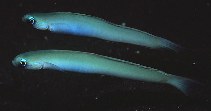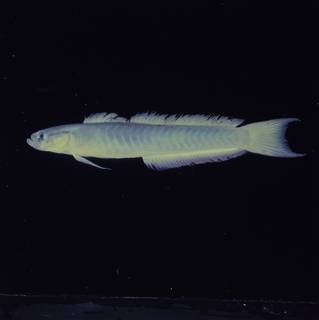WoRMS taxon details
Ptereleotris monoptera Randall & Hoese, 1985
219621 (urn:lsid:marinespecies.org:taxname:219621)
accepted
Species
marine, brackish, fresh, terrestrial
Randall, J.E.; Hoese, D.F. (1985). Revision of the Indo-Pacific dartfishes, genus <i>Ptereleotris</i> (Perciformes: Gobioidei). Indo-Pac. Fish. (7):36 p. [details]
Description Occurs in pairs and its burrow may be in coral rock or sand. They tend to form large, though diffuse, colonies; may be due...
Description Occurs in pairs and its burrow may be in coral rock or sand. They tend to form large, though diffuse, colonies; may be due to a propensity to aggregate or may be a result of the ecological requirements for the species (for which type of substratum, current pattern, and water depth among the most important) which restrict the areas of settlement of the postlarvae. [details]
Froese, R. and D. Pauly. Editors. (2024). FishBase. Ptereleotris monoptera Randall & Hoese, 1985. Accessed through: World Register of Marine Species at: https://marinespecies.org/aphia.php?p=taxdetails&id=219621 on 2024-04-26
Date
action
by
![]() The webpage text is licensed under a Creative Commons Attribution-Noncommercial 4.0 License
The webpage text is licensed under a Creative Commons Attribution-Noncommercial 4.0 License
original description
Randall, J.E.; Hoese, D.F. (1985). Revision of the Indo-Pacific dartfishes, genus <i>Ptereleotris</i> (Perciformes: Gobioidei). Indo-Pac. Fish. (7):36 p. [details]
basis of record Froese, R. & D. Pauly (Editors). (2023). FishBase. World Wide Web electronic publication. version (02/2023)., available online at https://www.fishbase.org [details]
ecology source Looby, A.; Erbe, C.; Bravo, S.; Cox, K.; Davies, H. L.; Di Iorio, L.; Jézéquel, Y.; Juanes, F.; Martin, C. W.; Mooney, T. A.; Radford, C.; Reynolds, L. K.; Rice, A. N.; Riera, A.; Rountree, R.; Spriel, B.; Stanley, J.; Vela, S.; Parsons, M. J. G. (2023). Global inventory of species categorized by known underwater sonifery. <em>Scientific Data.</em> 10(1). (look up in IMIS), available online at https://doi.org/10.1038/s41597-023-02745-4 [details]
basis of record Froese, R. & D. Pauly (Editors). (2023). FishBase. World Wide Web electronic publication. version (02/2023)., available online at https://www.fishbase.org [details]
ecology source Looby, A.; Erbe, C.; Bravo, S.; Cox, K.; Davies, H. L.; Di Iorio, L.; Jézéquel, Y.; Juanes, F.; Martin, C. W.; Mooney, T. A.; Radford, C.; Reynolds, L. K.; Rice, A. N.; Riera, A.; Rountree, R.; Spriel, B.; Stanley, J.; Vela, S.; Parsons, M. J. G. (2023). Global inventory of species categorized by known underwater sonifery. <em>Scientific Data.</em> 10(1). (look up in IMIS), available online at https://doi.org/10.1038/s41597-023-02745-4 [details]
 Present
Present  Present in aphia/obis/gbif/idigbio
Present in aphia/obis/gbif/idigbio  Inaccurate
Inaccurate  Introduced: alien
Introduced: alien  Containing type locality
Containing type locality
From other sources
Description Occurs in pairs and its burrow may be in coral rock or sand. They tend to form large, though diffuse, colonies; may be due to a propensity to aggregate or may be a result of the ecological requirements for the species (for which type of substratum, current pattern, and water depth among the most important) which restrict the areas of settlement of the postlarvae. [details]
| Language | Name | |
|---|---|---|
| Japanese | ヒメユリハゼ | [details] |
To Barcode of Life (20 barcodes)
To Biological Information System for Marine Life (BISMaL)
To European Nucleotide Archive (ENA)
To FishBase
To FishBase images (Ptereleotris monoptera, Indonesia, by Randall, J.E.)
To GenBank (29 nucleotides; 29 proteins)
To IUCN Red List (Least Concern)
To NMNH Extant Collection (Ptereleotris monoptera FIN030848 Slide 120 mm)
To NMNH Extant Collection (Ptereleotris monoptera FIN030849 Slide 120 mm)
To ITIS
To Biological Information System for Marine Life (BISMaL)
To European Nucleotide Archive (ENA)
To FishBase
To FishBase images (Ptereleotris monoptera, Indonesia, by Randall, J.E.)
To GenBank (29 nucleotides; 29 proteins)
To IUCN Red List (Least Concern)
To NMNH Extant Collection (Ptereleotris monoptera FIN030848 Slide 120 mm)
To NMNH Extant Collection (Ptereleotris monoptera FIN030849 Slide 120 mm)
To ITIS


